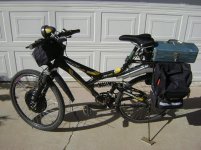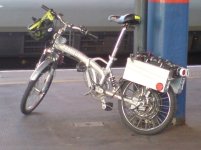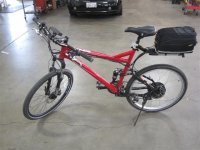Ebike1: (DayGlo Avenger MkIb) Standard Columbia 21-speed Al-frame hardtail with front shocks, 26" Al wheels. Twin 4-pole axial-flux brushed radiator-fan pancake motor friction drive, using rollerskate wheels to rear tire tread center. Controller= heavily modified ScootNGo brushed controller, driving motors in parallel @36V, 3x 12V 12Ah SLA in various physical configurations from rear baskets to triangle mount.
Pros: practically free.

Very simple construction. Reasonably decent balance with batteries in triangle, but really sucked before I moved them there. Decent range and speed before I killed the already well-used SLAs by overdischarging, overheating, and improperly charging them. Silent.
Cons: too heavy to lift, too heavy for any kickstands (broke multiple ones), can't use bus racks or light rail hangers. Skate wheels are too hard and slipped when tire was wet. Shafts of motors are too thin, can't really handle the stress of directly rolling on wheel--one eventually broke at the circlip groove inside the case. Poor torque (had to pedal to start going as motors couldn't really do it themselves very well). Uncomfortable regardless of saddle type (hate saddles). SLAs suck.
Ebike2: (CrazyBike2) Custom-built steel-frame semi-recumbent cargo bike; 24" steel wheels; 18 speeds. First a 300w-ish 2-pole then a 650w-ish 4-pole brushed powerchair motor w/gearbox driving the bike thru the regular chain drive, powered first by the modified ScootNGo controller from DGA, then a modified 2QD, and now a Curtis 1204-410. First ran on 24V, then raised to 36V, then 48V, First using 2x 12V 31Ah gel SLA from a powerchair, then using 3x and now 4x 12V 17Ah AGM SLA (from a server UPS), mounted in various configurations from rear cargo pods to center-frame-mounted.
Pros: Practically free.

Very good balance at speed--faster you go the better it rides (unpowered at 40MPH downhill it's really nice). Excellent acceleration. No problems with startups even with heavy cargo; takes load off my knees entirely. Most comfy bike I've ever ridden. 80+ pound cargo capacity without diminishing acceleration much. Excellent learning experience.

Charging is easy at 48V, using two 24V SLA chargers from powerchairs. @36V was harder but still ok, using Sorenson lab power supply (took a lot longer).
Cons: very complex construction. Far too heavy to lift, or even to ride without motor assist, really. Really hard to start from a stop without the motor assist. Bike style and weight both preclude using bus racks or light rail hangers. Motor powerful enough to destroy chainrings/etc. when alignment problems occur. Really hard to stop from high speeds--rim brakes simply insufficient. So heavy that potholes break rear wheels; needs rear suspension. Fairly noisy partly from chain drive and partly from gearbox. SLAs suck.
Ebike3: (DayGlo Avenger MkII) DGAmI with original motor system removed, and changed to a used front Fusin 36V geared hubmotor, Fusin controller, powered from a used 36V 9Ah Giant NiMH pack. Controller and battery mounted in rear left cargo pod.
Pros: Relatively inexpensive. Decent balance. Acceptable acceleration. Good speed. Charging relatively easy using current-limited Sorenson lab supplies. Good range. Very simple construction. Little pedalling is required to go anywhere I need to (but I prefer to pedal a lot, just not during starts from a stop due to bad knees). Can use on bus racks or light rail hangers if I need to go all the way across town without riding the whole way. Pretty quiet when at speed but fairly noisy during acceleration. NiMH is much better than SLA.

Cons: Charging is slow due to not having NiMH-specific charger, must watch temperature/voltage manually--takes at least overnight unless I sit right there and monitor it so I can turn up the current limit (safer to charge at 150mA and leave it till I have 1.5x Ah in vs pulled out). Still a little heavy but acceptable--can at least lift it easily. Front wheel loses traction at times with cargo in rear pod and on rear rack, especially at starts from intersections where I am pointing slightly uphill due to road design. Saddles still suck.










